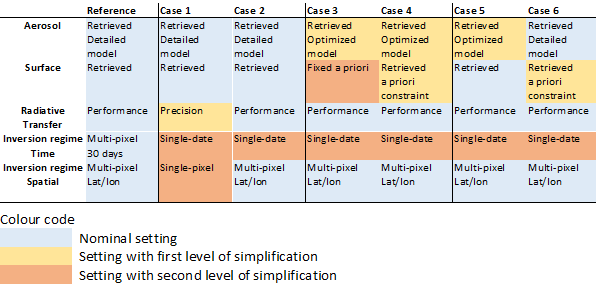30 January 2023
20 January 2020
Aerosol composition and associated spatial distribution are key parameters for the improvement of the air quality and climate products. Therefore, EUMETSAT will increase the number of satellite aerosol parameters provided operationally, which are driven by the 3MI instrument. The Multi-Viewing Multi-Channel Multi-Polarisation Imaging (3MI) instrument is planned to fly on the Metop-SG A satellites, as part of the EUMETSAT Polar System-Second Generation (EPS-SG) mission, in the timeframe beyond 2022. It is a radiometer dedicated to aerosol and cloud characterisation for climate monitoring, atmospheric composition, air quality and numerical weather prediction.
This polarimetric instrument is a heritage of the POLDER instruments, with improved capabilities. The spectral range (12 channels) was extended from the visible-near-infrared (410 to 910 nm) to the shortwave-infrared domain (up to 2200 nm). The spatial resolution (4 km at nadir) and the swath (2200 × 2200 km2) were also improved compared to previous POLDER instruments. As POLDER, 3MI will provide multi-polarisation (-60°, 0°, and +60°), and multi-angular (10 to 14 views) images of the Earth top of atmosphere outgoing radiance.
The level 1 products available to the users will be the geolocated Stokes vectors on the native geometry (Level 1B) and the geoprojected multi-directional and spectral Stokes vectors. Level-2 products will provide geophysical and microphysical parameters for aerosols and clouds. The aerosol retrieval for the 3MI operational product will use the GRASP algorithm. The retrieval provides extended set of aerosol and reflectance surface parameters.
GRASP (Generalized Retrieval of Aerosol and Surface Properties) is a highly accurate aerosol retrieval algorithm that processes properties of aerosol and land surface reflectance. It infers nearly 50 aerosol and surface parameters, including particle size distribution, the spectral index of refraction, and the degree of sphericity and absorption. The algorithm is designed for the enhanced characterisation of aerosol properties from spectral, multi-angular polarimetric remote sensing observations. GRASP works under different conditions, including bright surfaces such as deserts, where the reflectance overwhelms the signal of aerosols. GRASP has demonstrated a strong reliability for aerosol retrieval and characterisation on the PARASOL mission.
Objectives
The aim of this study is to assess the use (e.g. computationally expensive elements, sensitivity studies) of the GRASP algorithm for future optimisation, in order to update the day 1 3MI Level 2 aerosol product generation which has a non-sufficient level of performances. This is an important and urgent step, as the PDAP development (i.e. the ground segment) is ongoing and preparation of the new 3MI processing needs timely definition.
Overview
Assessment of the NRT use of GRASP for 3MI aerosol retrieval
This study has assessed GRASP in three distinctive regards, it has:
- Benchmarked the computational performance of GRASP with regard to NRT requirements.
- Analysed the possibilities of integrating GRASP in the PDAP ground segment.
- Evaluated the feasibility of specifying GRASP in a detailed specification.
All three assessments have a positive outcome, and therefore, no major blocker is to be expected for an operational integration of GRASP for EPS-SG/3MI from either of these three engineering perspectives.
To address these questions, six different settings of GRASP, described in table in Figure 1, have been tested and compared to the nominal performance of GRASP, as described at the GRASP-Open webpage. From the overall perspective, specifically the GRASP setup with fixed surface information or an initial guess for it — which can, and should be, taken from GRASP itself — show a good performance fitting within the NRT requirements, and the least amount of documentation effort.
Sensitivity studies of the 3MI-GRASP settings
Based on the efforts done within the project and described above, the following conclusions are drawn:
- The comparison with AERONET shows that all NRT retrieval settings produce feasible results in terms of accuracy, while in terms of performance some important differences are evident.
- Globally, Cases 4 and 6 are recommended as the best setting for 3MI NRT operational processing (see table).
- At the same time, Case 5 (see table) also shows very solid results without using any a priori constraints for surface reflectance. Therefore, Case 5 can also be considered as a candidate for operational 3MI NTR processing.
In terms of quality:
- All NTR retrieval approaches provide comparable images of surface reflectance and main aerosol parameters, such as aerosol optical depth (AOD), aerosol angstrom (AE) and single scattering albedo (SSA).
- Cases 4 and 6 settings (see table) provide the best correlation with available AERONET data that are, overall, comparable with quality of reference retrievals for AOD and slightly less performant for AE.
- Case 5 (see table), which did not rely on any a priori constraints about surface reflectance, also provided solid non-biased correlation.
- The above-mentioned results and settings are based on first level analysis and a deeper quantitative analysis has to be conducted, such as the algorithm stability with additional settings (spatial and temporal).
In terms of compute resources:
- The processing of PARASOL/POLDER data in this project has not been set up to provide reliable benchmark metrics. The study has shown the performance in a batch processing scenario, plus all timings were performed with a dataset different to 3MI and a processing facility different to the future EPS-SG PDAP. Therefore, the only reliable timing metric can be the relative difference between the various settings.
- All NTR retrieval approaches with Cases 2 to 6 settings (see table), provide comparable performance with a median time per PARASOL/POLDER pixel ranging from 0.4 to 0.5 core-seconds for processing data off the archive. This roughly translate to a 10–20 min processing time of one orbit using 100 cores for computation. Considering a more effective in-memory or, at least, node-local data processing, the Cases 2 to 6 retrieval scenarios are fully acceptable for 3MI NRT processing in terms of performance.
- The Case 1 settings (see table), which use the most accurate RT calculations, require about 10 times more computation time compared to the Cases 2 to 6 retrievals. At the same time, Cases 4, 5 and 6 retrievals provide the retrieval of comparable quality with Case 1. Thus, Case 1 settings are not recommended for further consideration for 3MI NRT processing.



